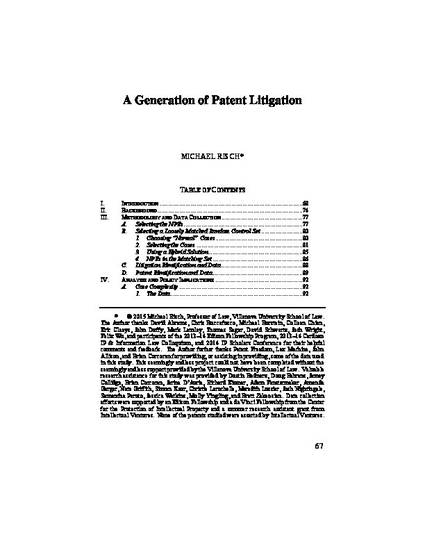
Article
A Generation of Patent Litigation
San Diego Law Review
(2015)
Abstract
This study compares twenty-five years of litigation and patents of the ten most litigious NPEs (as of 2009) with a random group of cases and patents in the same yearly proportions. All cases involving every patent was gathered, allowing the life cycle of each asserted patent to be studied. The data includes litigation data, patent data, reexaminations, and other relevant data. This paper considers outcomes and patent quality. A future paper will examine innovation and markets.
Unsurprisingly, the data shows that the studied NPE patents were found invalid and noninfringed about twice as often as the comparable nonNPEs. But there is more to the story. First, summary judgment challenges were denied at about the same rate. Second, most cases never tested the patent at all: the invalidations were bunched into 3% of the cases. Third, about 17% of the NPE cases involved a patent that was later invalidated, as compared to 3% for the nonNPEs. This left 75% of NPE cases with patents that were never tested and did not involve a patent invalidated at any time (as compared to 90% of nonNPE cases). Thus, one’s view of the data will depend on views about motivations in asserting patents that wind up invalid later and the merits of settlements. The paper presents data about settlements, consent judgments, defaults, and the like, but ultimately takes no position on the quality of untested patents.
Other major findings include:
1. NPE cases are shorter duration than nonNPE cases, even though they are transferred and consolidated more often. Even with transferred cases, NPE cases are shorter.
2. A patent’s likelihood of being invalidated has almost nothing to do with objectively observable patent metrics – including reexamination data. Instead, the odds of invalidation are driven by those cases that are more likely to have a challenge, like the number of defendants or number of patents in the case. Once variables that indicate challenges are considered, a party's status as NPE added no explanatory power.
3. One patent metric was statistically significant in predicting invalidation: backward citations, or the number of prior patents that a patent refers to. But the sign was surprising: the more citations in the patent, the more likely it was found invalid. This may mean that backward citations are another selection variable – patents citing many other patents may be more likely to be highly controversial and thus challenged. This finding implies, however, that “gold plating” patents may not be as beneficial as first thought.
Disciplines
Publication Date
2015
Citation Information
Michael Risch. "A Generation of Patent Litigation" San Diego Law Review Vol. 52 (2015) Available at: http://works.bepress.com/michael_risch/23/
